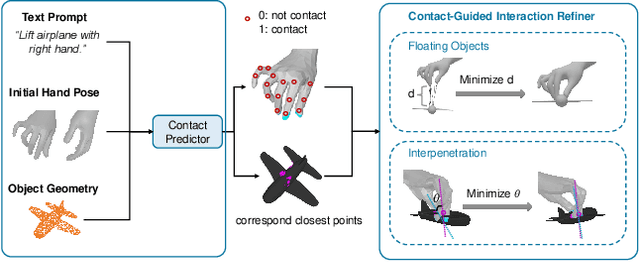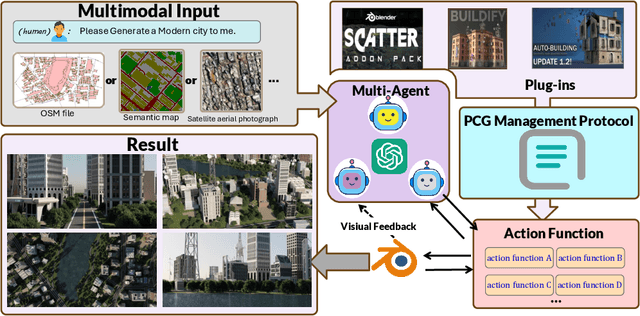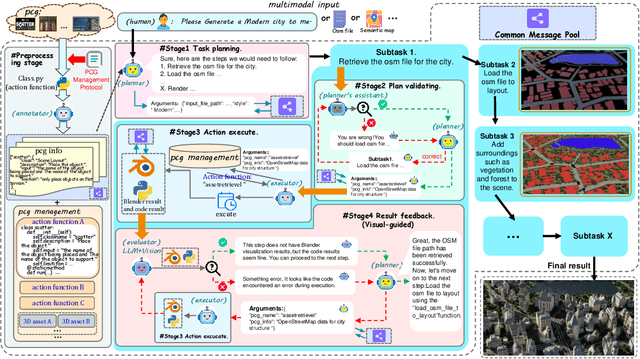Yuxi Wang
Topology-Aware Graph Reinforcement Learning for Dynamic Routing in Cloud Networks
Sep 05, 2025Abstract:This paper proposes a topology-aware graph reinforcement learning approach to address the routing policy optimization problem in cloud server environments. The method builds a unified framework for state representation and structural evolution by integrating a Structure-Aware State Encoding (SASE) module and a Policy-Adaptive Graph Update (PAGU) mechanism. It aims to tackle the challenges of decision instability and insufficient structural awareness under dynamic topologies. The SASE module models node states through multi-layer graph convolution and structural positional embeddings, capturing high-order dependencies in the communication topology and enhancing the expressiveness of state representations. The PAGU module adjusts the graph structure based on policy behavior shifts and reward feedback, enabling adaptive structural updates in dynamic environments. Experiments are conducted on the real-world GEANT topology dataset, where the model is systematically evaluated against several representative baselines in terms of throughput, latency control, and link balance. Additional experiments, including hyperparameter sensitivity, graph sparsity perturbation, and node feature dimensionality variation, further explore the impact of structure modeling and graph updates on model stability and decision quality. Results show that the proposed method outperforms existing graph reinforcement learning models across multiple performance metrics, achieving efficient and robust routing in dynamic and complex cloud networks.
HLG: Comprehensive 3D Room Construction via Hierarchical Layout Generation
Aug 25, 2025Abstract:Realistic 3D indoor scene generation is crucial for virtual reality, interior design, embodied intelligence, and scene understanding. While existing methods have made progress in coarse-scale furniture arrangement, they struggle to capture fine-grained object placements, limiting the realism and utility of generated environments. This gap hinders immersive virtual experiences and detailed scene comprehension for embodied AI applications. To address these issues, we propose Hierarchical Layout Generation (HLG), a novel method for fine-grained 3D scene generation. HLG is the first to adopt a coarse-to-fine hierarchical approach, refining scene layouts from large-scale furniture placement to intricate object arrangements. Specifically, our fine-grained layout alignment module constructs a hierarchical layout through vertical and horizontal decoupling, effectively decomposing complex 3D indoor scenes into multiple levels of granularity. Additionally, our trainable layout optimization network addresses placement issues, such as incorrect positioning, orientation errors, and object intersections, ensuring structurally coherent and physically plausible scene generation. We demonstrate the effectiveness of our approach through extensive experiments, showing superior performance in generating realistic indoor scenes compared to existing methods. This work advances the field of scene generation and opens new possibilities for applications requiring detailed 3D environments. We will release our code upon publication to encourage future research.
Federated Anomaly Detection for Multi-Tenant Cloud Platforms with Personalized Modeling
Aug 14, 2025Abstract:This paper proposes an anomaly detection method based on federated learning to address key challenges in multi-tenant cloud environments, including data privacy leakage, heterogeneous resource behavior, and the limitations of centralized modeling. The method establishes a federated training framework involving multiple tenants. Each tenant trains the model locally using private resource usage data. Through parameter aggregation, a global model is optimized, enabling cross-tenant collaborative anomaly detection while preserving data privacy. To improve adaptability to diverse resource usage patterns, a personalized parameter adjustment mechanism is introduced. This allows the model to retain tenant-specific feature representations while sharing global knowledge. In the model output stage, the Mahalanobis distance is used to compute anomaly scores. This enhances both the accuracy and stability of anomaly detection. The experiments use real telemetry data from a cloud platform to construct a simulated multi-tenant environment. The study evaluates the model's performance under varying participation rates and noise injection levels. These comparisons demonstrate the proposed method's robustness and detection accuracy. Experimental results show that the proposed method outperforms existing mainstream models across key metrics such as Precision, Recall, and F1-Score. It also maintains stable performance in various complex scenarios. These findings highlight the method's practical potential for intelligent resource monitoring and anomaly diagnosis in cloud computing environments.
F2PASeg: Feature Fusion for Pituitary Anatomy Segmentation in Endoscopic Surgery
Aug 07, 2025Abstract:Pituitary tumors often cause deformation or encapsulation of adjacent vital structures. Anatomical structure segmentation can provide surgeons with early warnings of regions that pose surgical risks, thereby enhancing the safety of pituitary surgery. However, pixel-level annotated video stream datasets for pituitary surgeries are extremely rare. To address this challenge, we introduce a new dataset for Pituitary Anatomy Segmentation (PAS). PAS comprises 7,845 time-coherent images extracted from 120 videos. To mitigate class imbalance, we apply data augmentation techniques that simulate the presence of surgical instruments in the training data. One major challenge in pituitary anatomy segmentation is the inconsistency in feature representation due to occlusions, camera motion, and surgical bleeding. By incorporating a Feature Fusion module, F2PASeg is proposed to refine anatomical structure segmentation by leveraging both high-resolution image features and deep semantic embeddings, enhancing robustness against intraoperative variations. Experimental results demonstrate that F2PASeg consistently segments critical anatomical structures in real time, providing a reliable solution for intraoperative pituitary surgery planning. Code: https://github.com/paulili08/F2PASeg.
On Path to Multimodal Historical Reasoning: HistBench and HistAgent
May 26, 2025Abstract:Recent advances in large language models (LLMs) have led to remarkable progress across domains, yet their capabilities in the humanities, particularly history, remain underexplored. Historical reasoning poses unique challenges for AI, involving multimodal source interpretation, temporal inference, and cross-linguistic analysis. While general-purpose agents perform well on many existing benchmarks, they lack the domain-specific expertise required to engage with historical materials and questions. To address this gap, we introduce HistBench, a new benchmark of 414 high-quality questions designed to evaluate AI's capacity for historical reasoning and authored by more than 40 expert contributors. The tasks span a wide range of historical problems-from factual retrieval based on primary sources to interpretive analysis of manuscripts and images, to interdisciplinary challenges involving archaeology, linguistics, or cultural history. Furthermore, the benchmark dataset spans 29 ancient and modern languages and covers a wide range of historical periods and world regions. Finding the poor performance of LLMs and other agents on HistBench, we further present HistAgent, a history-specific agent equipped with carefully designed tools for OCR, translation, archival search, and image understanding in History. On HistBench, HistAgent based on GPT-4o achieves an accuracy of 27.54% pass@1 and 36.47% pass@2, significantly outperforming LLMs with online search and generalist agents, including GPT-4o (18.60%), DeepSeek-R1(14.49%) and Open Deep Research-smolagents(20.29% pass@1 and 25.12% pass@2). These results highlight the limitations of existing LLMs and generalist agents and demonstrate the advantages of HistAgent for historical reasoning.
EmoDiffusion: Enhancing Emotional 3D Facial Animation with Latent Diffusion Models
Mar 14, 2025Abstract:Speech-driven 3D facial animation seeks to produce lifelike facial expressions that are synchronized with the speech content and its emotional nuances, finding applications in various multimedia fields. However, previous methods often overlook emotional facial expressions or fail to disentangle them effectively from the speech content. To address these challenges, we present EmoDiffusion, a novel approach that disentangles different emotions in speech to generate rich 3D emotional facial expressions. Specifically, our method employs two Variational Autoencoders (VAEs) to separately generate the upper face region and mouth region, thereby learning a more refined representation of the facial sequence. Unlike traditional methods that use diffusion models to connect facial expression sequences with audio inputs, we perform the diffusion process in the latent space. Furthermore, we introduce an Emotion Adapter to evaluate upper face movements accurately. Given the paucity of 3D emotional talking face data in the animation industry, we capture facial expressions under the guidance of animation experts using LiveLinkFace on an iPhone. This effort results in the creation of an innovative 3D blendshape emotional talking face dataset (3D-BEF) used to train our network. Extensive experiments and perceptual evaluations validate the effectiveness of our approach, confirming its superiority in generating realistic and emotionally rich facial animations.
Cloud Removal With PolSAR-Optical Data Fusion Using A Two-Flow Residual Network
Jan 14, 2025Abstract:Optical remote sensing images play a crucial role in the observation of the Earth's surface. However, obtaining complete optical remote sensing images is challenging due to cloud cover. Reconstructing cloud-free optical images has become a major task in recent years. This paper presents a two-flow Polarimetric Synthetic Aperture Radar (PolSAR)-Optical data fusion cloud removal algorithm (PODF-CR), which achieves the reconstruction of missing optical images. PODF-CR consists of an encoding module and a decoding module. The encoding module includes two parallel branches that extract PolSAR image features and optical image features. To address speckle noise in PolSAR images, we introduce dynamic filters in the PolSAR branch for image denoising. To better facilitate the fusion between multimodal optical images and PolSAR images, we propose fusion blocks based on cross-skip connections to enable interaction of multimodal data information. The obtained fusion features are refined through an attention mechanism to provide better conditions for the subsequent decoding of the fused images. In the decoding module, multi-scale convolution is introduced to obtain multi-scale information. Additionally, to better utilize comprehensive scattering information and polarization characteristics to assist in the restoration of optical images, we use a dataset for cloud restoration called OPT-BCFSAR-PFSAR, which includes backscatter coefficient feature images and polarization feature images obtained from PoLSAR data and optical images. Experimental results demonstrate that this method outperforms existing methods in both qualitative and quantitative evaluations.
OOD-HOI: Text-Driven 3D Whole-Body Human-Object Interactions Generation Beyond Training Domains
Nov 27, 2024



Abstract:Generating realistic 3D human-object interactions (HOIs) from text descriptions is a active research topic with potential applications in virtual and augmented reality, robotics, and animation. However, creating high-quality 3D HOIs remains challenging due to the lack of large-scale interaction data and the difficulty of ensuring physical plausibility, especially in out-of-domain (OOD) scenarios. Current methods tend to focus either on the body or the hands, which limits their ability to produce cohesive and realistic interactions. In this paper, we propose OOD-HOI, a text-driven framework for generating whole-body human-object interactions that generalize well to new objects and actions. Our approach integrates a dual-branch reciprocal diffusion model to synthesize initial interaction poses, a contact-guided interaction refiner to improve physical accuracy based on predicted contact areas, and a dynamic adaptation mechanism which includes semantic adjustment and geometry deformation to improve robustness. Experimental results demonstrate that our OOD-HOI could generate more realistic and physically plausible 3D interaction pose in OOD scenarios compared to existing methods.
Enhancing Sound Source Localization via False Negative Elimination
Aug 29, 2024



Abstract:Sound source localization aims to localize objects emitting the sound in visual scenes. Recent works obtaining impressive results typically rely on contrastive learning. However, the common practice of randomly sampling negatives in prior arts can lead to the false negative issue, where the sounds semantically similar to visual instance are sampled as negatives and incorrectly pushed away from the visual anchor/query. As a result, this misalignment of audio and visual features could yield inferior performance. To address this issue, we propose a novel audio-visual learning framework which is instantiated with two individual learning schemes: self-supervised predictive learning (SSPL) and semantic-aware contrastive learning (SACL). SSPL explores image-audio positive pairs alone to discover semantically coherent similarities between audio and visual features, while a predictive coding module for feature alignment is introduced to facilitate the positive-only learning. In this regard SSPL acts as a negative-free method to eliminate false negatives. By contrast, SACL is designed to compact visual features and remove false negatives, providing reliable visual anchor and audio negatives for contrast. Different from SSPL, SACL releases the potential of audio-visual contrastive learning, offering an effective alternative to achieve the same goal. Comprehensive experiments demonstrate the superiority of our approach over the state-of-the-arts. Furthermore, we highlight the versatility of the learned representation by extending the approach to audio-visual event classification and object detection tasks. Code and models are available at: https://github.com/zjsong/SACL.
CityX: Controllable Procedural Content Generation for Unbounded 3D Cities
Jul 29, 2024



Abstract:Generating a realistic, large-scale 3D virtual city remains a complex challenge due to the involvement of numerous 3D assets, various city styles, and strict layout constraints. Existing approaches provide promising attempts at procedural content generation to create large-scale scenes using Blender agents. However, they face crucial issues such as difficulties in scaling up generation capability and achieving fine-grained control at the semantic layout level. To address these problems, we propose a novel multi-modal controllable procedural content generation method, named CityX, which enhances realistic, unbounded 3D city generation guided by multiple layout conditions, including OSM, semantic maps, and satellite images. Specifically, the proposed method contains a general protocol for integrating various PCG plugins and a multi-agent framework for transforming instructions into executable Blender actions. Through this effective framework, CityX shows the potential to build an innovative ecosystem for 3D scene generation by bridging the gap between the quality of generated assets and industrial requirements. Extensive experiments have demonstrated the effectiveness of our method in creating high-quality, diverse, and unbounded cities guided by multi-modal conditions. Our project page: https://cityx-lab.github.io.
 Add to Chrome
Add to Chrome Add to Firefox
Add to Firefox Add to Edge
Add to Edge